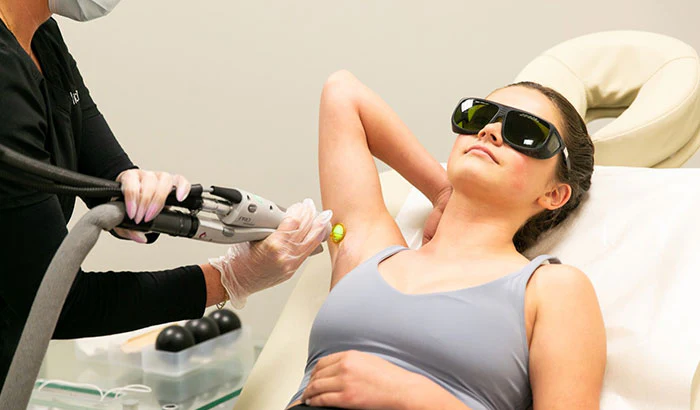A Thorough Testimonial of Hair Removal Laser Solution and Their Benefits
A Thorough Testimonial of Hair Removal Laser Solution and Their Benefits
Blog Article
A Detailed Summary of Numerous Laser Hair Elimination Techniques: Selecting the Right Technique for Your Skin Kind and Hair Color
When checking out laser hair elimination, recognizing the nuances of various methods in connection with specific skin types and hair colors is vital. Strategies such as Alexandrite, diode, and Nd: YAG lasers each serve distinctive objectives, satisfying certain combinations of skin tone and coloring. The effectiveness of these approaches can vary considerably based upon an individual's unique qualities, making a tailored approach important. As we analyze the ins and outs of these innovations, one have to consider not only the technique yet additionally the effects of skin kind and hair shade on therapy end results. What variables should you focus on when making your choice?

Review of Laser Hair Elimination
Laser hair elimination is a preferred cosmetic treatment that uses focused light beams of light to target and remove unwanted hair. This method offers a semi-permanent remedy for hair decrease by harmful hair follicles with laser energy, which inhibits future hair development. Commonly executed in a scientific setup, the procedure is suitable for numerous body locations, including the legs, underarms, and facial areas.
Throughout the treatment, a specialized device emits laser light that is soaked up by the pigment in the hair roots. The efficiency of the procedure greatly depends upon the contrast in between the complexion and hair color, as darker hair soaks up a lot more light. Clients frequently call for several sessions to achieve optimum results, as hair grows in cycles and not all hair follicles are active simultaneously.

Sorts Of Laser Technologies
Various laser modern technologies have been created to improve the effectiveness of hair elimination therapies, each created to satisfy various skin types and hair colors. One of the most frequently used laser kinds consist of Alexandrite, Diode, and Nd: YAG lasers.
The Alexandrite laser runs at a wavelength of 755 nm, making it particularly efficient for lighter complexion and finer hair. Its quick pulse rate permits faster treatments, which can be helpful for larger locations. Conversely, the Diode laser, with a wavelength of 800-810 nm, is versatile and can deal with a large range of skin kinds. It is specifically effective for darker hair and is commonly preferred for its effectiveness and convenience.
The Nd: YAG laser operates at a longer wavelength of 1064 nm, which passes through much deeper into the skin. This makes it appropriate for darker complexion, as it decreases the risk of pigmentation adjustments. In addition, it can effectively target coarse hair.
Comprehending these innovations is critical for choosing the most appropriate laser treatment, as each kind offers unique advantages based on private hair and skin features. Correct appointment with an experienced specialist can direct individuals in the direction of one of the most reliable remedy for their specific demands.
Skin Kind Factors To Consider
How do skin kinds affect the performance of laser hair elimination treatments? The comparison in between the hair and skin color allows for optimum absorption of laser energy by the hair roots, reducing damages to bordering skin.
On the other hand, darker skin kinds (IV-VI) existing challenges as a result of increased melanin levels. Greater melanin can take in even more laser energy, possibly resulting in skin burns or pigmentation changes. For these skin kinds, specialized lasers such as Nd: YAG are usually advised, as they target hair roots more precisely while minimizing skin absorption.
Furthermore, people with reactive or delicate skin might require a customized approach. Pre-treatment appointments are necessary to examine skin disease and background, allowing practitioners to personalize settings and select the most suitable laser technology. Eventually, understanding skin kind considerations makes sure not only the efficiency of laser hair removal yet also the safety and security and complete satisfaction of the patient.
Hair Color Compatibility
The efficiency of laser hair elimination is significantly affected by hair shade compatibility. Laser hair removal operates on the concept of selective photothermolysis, where the laser targets melanin, the pigment in hair. People with darker hair shades, such as brownish and black, usually experience more efficient outcomes due to the greater melanin focus, which soaks up the laser energy a lot more successfully.
In comparison, individuals with lighter hair colors, such as blonde, red, or gray, may deal with obstacles in attaining optimum results. hair removal laser. These hair kinds consist of much less melanin, which can cause not enough absorption of the laser power. This difference often demands using alternate hair elimination techniques for those with lighter hair, as standard lasers might not successfully target the hair roots
Current improvements in laser innovation have introduced specialized tools that can much better fit a broader spectrum of hair colors. It remains critical for possible people to seek advice from with qualified professionals that can examine their particular hair shade and skin type to determine the most suitable laser hair removal choices. Recognizing hair color compatibility is crucial for optimizing treatment effectiveness and accomplishing wanted hair reduction outcomes.
Picking the Right Method
Selecting the most proper technique for laser hair removal needs careful consideration of numerous factors, including hair color, skin type, and private choices. Darker hair on lighter skin normally reacts best to standard approaches like the Alexandrite and Diode lasers, which are designed to target visit the site melanin efficiently.
Furthermore, the density and coarseness of hair can affect the choice of technique. Some methods might be a company website lot more efficient for great hair, while others might stand out with crude hair. Patients ought to additionally consider their discomfort resistance and the downtime related to each method, as some lasers may lead to more pain or need longer recuperation durations.
Inevitably, a comprehensive assessment with an accredited professional is crucial to assess individual needs and skin characteristics. By taking these elements into account, clients can make informed decisions that align with their desired outcomes and ensure a safe, reliable laser hair elimination experience.
Verdict
Elements such as skin kind and hair color considerably affect the effectiveness and security of different laser technologies. Alexandrite, diode, and Nd: YAG lasers each offer distinctive benefits tailored to particular skin tones and hair coloring.
When checking out laser hair elimination, comprehending the nuances of various strategies in connection to specific skin types and hair shades is vital. The comparison between the hair and skin shade allows for ideal absorption of laser power by the hair follicles, decreasing damage to bordering skin.
Laser hair elimination operates on the concept of selective photothermolysis, where the laser targets melanin, the pigment in hair. It stays critical for potential people to seek advice from with certified professionals that can evaluate their details hair shade and skin type to identify the most suitable laser hair elimination alternatives.Selecting the most proper approach find for laser hair removal needs cautious factor to consider of several elements, consisting of hair shade, skin type, and individual preferences.
Report this page